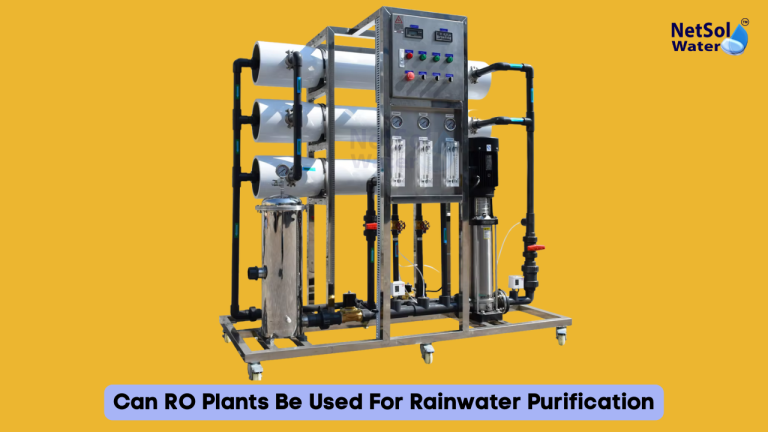
In many locations, rainwater can help satisfy water needs. A top trusted manufacturer of water treatment plant systems is Commercial RO Plant. The business continuously prepares RO plants & purifies water for numerous customers. Every system aims to rid water of dangerous substances. At first appearance, rainwater could appear to be pure. It can contain microorganisms, dust, plus soot. Its mineral composition & pH can change. If these issues are not adequately addressed, they may present health problems. All of these problems can be resolved by a RO plant. It prevents sediments, bacteria, & salts by forcing water through thin membranes. Some compounds can also be cut by it. A common question from customers is whether rainwater may be fed into a RO plant. It this blog we will display can RO plants be used for rainwater purification.
We are going to show the practical application of this approach. Commercial RO Plant go over what rainwater requires. It will display such cases how Commercial RO plants can be integrated into a rainwater conserving system.
Having an understanding of rainwater quality
Rainwater gathers in tanks as well as on roofs. It leaves after collecting dust & soot. These things have the power to alter the water’s composition. A filter may become clogged. They may also be harmful to health. Treatment can be guided by an accurate understanding of these features. Now let’s examine some
1) On-Surface Pollutants
Sand, dirt, as well as debris from rooftops may be present in rainwater. If these particles are not eliminated initially, they may harm filters. Most of them can be stopped by a prefilter, protecting the main system.
2) Impurities in Chemical Manufacturing Facilities
Acid rain can add nitrogen in the form of nitrates from the air & change the pH. These elements need to be examined because they may have an impact on safety & flavor.
3) Microbiological Hazards
Sand Dust floating along with bird waste droppings can bring algae & bacteria with it. If the water is not treated, these bacteria can make people sick.
Fundamentals of Operating a RO Plant
To get rid of tiny particles, a RO plant forces water across a thin membrane. It can remove bacteria, salts, & a variety of other contaminants. Heavy metals (in solid forms) can be cut through it. Water gains exceptional purity & a neutral taste as a result of this technique. The type of water can affect both the flow & the pressure effort. Let’s examine some of these:
1) Function of Membranes
For the dissolved solids, the membrane serves as a barrier. It allows pure water to flow through while blocking ions & big molecules.
2) Needs for Right Amount of Pressure
Water must be forced through the membrane by the system at high pressure. For optimal results, the pump along with design must fit the characteristics of the rainwater.
3) Control Over Flow
In order to effectively purify without wasting water, valves & gauges help maintain the proper pressure & flow conditions.
Advantages of Rainwater Purification using RO
Rainwater that has been collected can be converted into safe drinking water using a RO plant. Over time, it can reduce reliance on other water sources. Long-term cost savings are possible. With clean water, it can sustain residences, workplaces, & farmland. It can produce pure water with no strange taste or odor. Let’s focus on examining several health & safety:
The system is capable of eliminating viruses, germs, including cysts. This process renders water suitable for cooking & drinking.
1) Adaptable Utilization
There are many possibilities of applications for purified rainwater. It can help replenish tanks for lab work, cooking, even laundry.
2) Impact of Costs
Developing their own rainwater supply can eventually save the customer money on municipal expenses & bottled water.
Difficulties in Implementing RO Plants to Purify Rainwater
There may be difficulties when working with such RO system. Seasons can affect the quality of rainwater. Membrane fouling along with temperature pressure swings could affect the system. Additional filters could be required to protect the membrane. Now let’s examine some as:
Before the Main Treatment
Large particles including sediments can be eliminated through a prefilter. It can diminish or trim down requirements for multiple services while helping support prolong membrane life.
Adjusting to the Variations in pH
After prolonged storage, the pH of rainwater may change. The membrane can be protected by balancing the pH with the addition of a basic substance.
Needs for Regular Maintenance
Periodically, the RO plant needs to be cleaned & inspected. In order to replace parts on time, the user must monitor pressure patterns.
Maintenance Upkeep of Rainwater Systems based RO Plants
With proper maintenance, this rainwater system can continue to function well. Consumers need to establish a regular check-up schedule. They have to examine membranes & filters. They are required to maintain track of performance metrics.
Typical Inspection
Every few months, check the filters to detect clogs early. Keep track of any decrease in water flow or increase in pressure.
Cleaning of Membranes
Follow the maker’s instructions to clean the membrane. To prevent harm while sustaining optimal performance, adopt gentle solutions.
Maintaining Records
After every inspection, log data on flow as well as pressure rate values are collected. These notes can assist in identifying problems early on.
Conclusion
Rainwater can be purified thus rendering it safe with a RO plant. Leading the way in the design & construction of these systems is Commercial RO Plant. For any situation, their professionals assess the water & select the appropriate filters. They guarantee sustained effectiveness & assistance. If you’re looking for a dependable way to purify your rainwater, consider about commercial RO plant. For extra details or to schedule a personalized consultation, please contact Commercial RO Plant right now.
